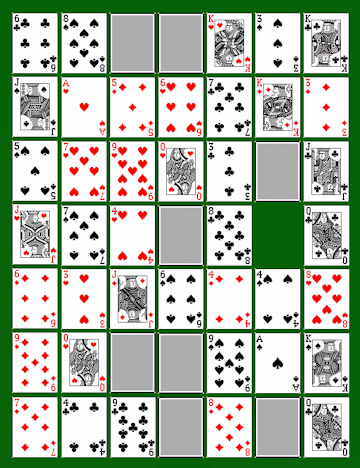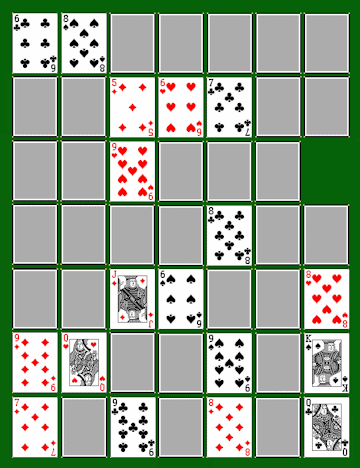Copyright
- Start
- Decide in advance who will play Red and who Black throughout the whole session. The turn to deal and to play alternates.
Remove the four Tens from a 52-card pack, thoroughly shuffle the remaining 48, and deal them face up in seven
rows of seven with a gap in the centre. (The first diagram shows a layout after eight moves have been made.)

You can move J but not
J but not
 4
4 - Object
- Each of you in turn, starting with non-dealer, turns a card of your own colour face down in accordance with the rules below. Your main aim is to be the last player able to turn a card down. A secondary aim is to turn down lower rather than higher numerals. For this purpose Ace counts 1 and numerals 2 to 9 at face value. Courts (face cards) each count 10 each to the winner but minus 10 to the loser.
- Play
- Starting with the non-dealer, and playing alternately, you each take any card of your own colour lying horizontally or
vertically in line with the gap, move it into the gap, and turn it face down,
leaving another gap where this card came from. For example, if you are playing
Red in the illustrated layout, you might at this point move the
 J five steps to the right, or the
J five steps to the right, or the
 K two steps down into the current gap,
thus leaving a new gap where you moved it from.
Continue in the same way, observing the following rules:
K two steps down into the current gap,
thus leaving a new gap where you moved it from.
Continue in the same way, observing the following rules:
- In moving to the gap, a numeral (A23456789) may not pass over a card
lying face down. Only courts (JQK) may jump over downcards. (So, in the illustration above,
you can move
 J but not
J but not
 4
to the right.)
4
to the right.) - If you can make a horizontal or vertical move, you must. If not, you must instead move a card of your colour that lies in a diagonal line with the gap. As before, only courts can jump over downcards.
- If you can't make a vertical, horizontal or diagonal move, you're stuck.
This ends the play and you have lost.

Red playing last would win by 72 to 33
- In moving to the gap, a numeral (A23456789) may not pass over a card
lying face down. Only courts (JQK) may jump over downcards. (So, in the illustration above,
you can move
- Score
-
If you were the last to move, you score the total face value of
all numerals of your own colour left face up, plus 10 for each of your face-up
court cards. If you lost, you score the total face value of all numerals of
your own colour left face up, but then deduct 10 for each of
your face-up court cards. In this example, Red has numerals totalling 52 and courts counting 20, Black
numerals counting 53 and courts 20, so Red playing last would win by 72 to 33, or Black playing last by 73 to 32.
Note The sooner one player gets stuck, the higher both players will score. - Game
- Play any even number of deals, alternating the first move.
- Set-up
- North and South are partners and play respectively spades and clubs. East and West are partners and play respectively hearts and diamonds. You each take the undealt Ten of your designated suit and place it face up on the table before you as an indicator card. Deal the other 48 out in seven rows and columns with a gap in the middle (as for two).
- Play
- North moves first in the first deal, and the turn to make the first move rotates to the left, as does the turn to play. At each turn you move a card of your own suit to the gap and turn it face down. Unlike in the two-player game, you are free to move your card orthogonally or diagonally, as you prefer, though still with the restriction that only a court card can jump over a downcard.
- Getting stuck
- When you get stuck, you turn your indicator card (the Ten of your suit) face down. This does not prevent you from moving on a subsequent turn if the possibility arises. If you can move again, you do so, and turn your indicator face up.
- Ending and scoring
- The game ends as soon as both members of one partnership get stuck, as indicated by both their Tens' being face down. Score as above, except that the winning side adds a bonus of 50 if both its members have their indicators face up at the time.
- Game
- A game is four deals and is won by the partnership with the highest cumulative score.

